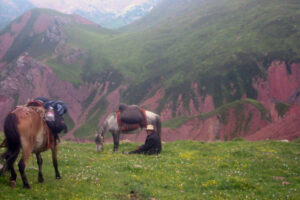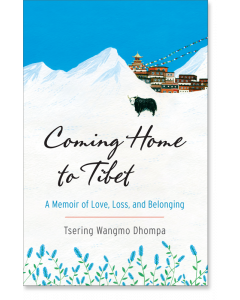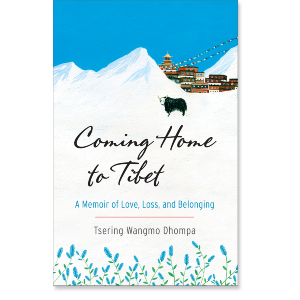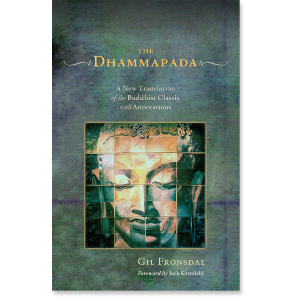by Kate, Production Coordinator/Designer


Tsering Wangmo Dhompa
Tsering Wangmo Dhompa is the first Tibetan female poet to be published in English. Her first book of poems, Rules of the House (Apogee Press, 2002), was a finalist for the Asian American Literary Awards in 2003. She was raised in India and Nepal and is fluent in several languages and dialects—including Tibetan, Hindi, and Nepali. Tsering received her BA from Lady Shri Ram College, Delhi University, her MA from University of Massachusetts in Amherst, and her MFA in Creative Writing from San Francisco State. Her poetry articulates the nostalgia of displaced Tibetans, recording the memories of elders in Tibetan communities.
Tsering Wangmo Dhompa
GUIDES

Judging Books by Their Covers: A Defense

I have a confession to make: I judge books by their covers. And I’m not even sorry about it.
I’m baffled by how many amazing books there are in the world that I’ll never have time to read. And there are more being released all the time! It can be so overwhelming to have to choose which books I’m going to make time for and which books I’m just going to have to pass over. There are loads of factors that go into making that decision, from the title, the content, my interests, my mood on any given day, recommendations from my friends, etc. But I’m a sucker for a beautiful or interesting cover, and every now and then, I give myself permission to ignore all of those important factors and instead choose solely for superficial reasons. Occasionally I pick up a book I wouldn’t otherwise read simply because I love the cover. And every now and then, this strategy leads to amazing finds and I become so grateful to have read it. So I’d like to present to you some of my favorite Shambhala books that I only read because I loved the covers—but I ended up loving the content, too.
Coming Home to Tibet
A Memoir of Love, Loss, and Belonging
Sure the colors are stunning. Sure the typography is delightful. But let’s be real here: I was 100% sold on this book because of the yak alone.
Coming Home to Tibet is Tsering Wangmo Dhompa’s memoir about coming home to a place she’s never actually lived. She was raised in exile by her single Tibetan mother who tragically died before being able to return to her homeland. It’s an incredible examination of the complexities of identity, which Dhompa expresses beautifully: “I have lived my life defined as a refugee in Nepal and India, a resident alien and immigrant in the United States. At last, I am a Tibetan in Tibet, a Khampa in Kham—albeit as a tourist in my occupied and tethered country” (94). But some of the most moving parts of the book are when Dhompa describes her relationship with her now-deceased mother: “When she died, I told myself I was fortunate to have had her love for twenty-three years. I believe still what I felt then: her love will see me through my lifetime, perhaps even a few lifetimes” (177). Her prose betrays her poetic background, resulting in lovely passages throughout the book, such as this one: “When there are just two of you, you appropriate images from each other and inhabit one tongue until the stories that compose your two worlds become interchangeable. It was so for my mother and me” (2). This is an honest and complex look at the tensions between past and present, tradition and modernity, faith and doubt, East and West, belonging and otherness.
The cover is an impossible representation of Tibet—I have a feeling vibrant blue flowers aren’t often found in abundance right next to snow-covered plains and frozen mountains. In this way, it couldn’t be a more perfect analogue for the author’s early experience of Tibet—a pieced together fantasy of a remote homeland based on her mother’s idealized memories rather than firsthand experience.
But my main point: how cute is that yak?!?
Zen Confidential
Confessions of a Wayward Monk
The charm of this cover is undeniable. You can’t not smile at the jovial, rotund jade buddha against the serene blue background. The image and the type perfectly capture Shozan Jack Haubner’s playful approach to sharing the down-and-dirty details of his path to becoming an American Zen monk.
In his own words, this book “is the deeply felt journey of a young man who crawled out of the anus of his own self-absorption, suffering, and despair . . . and lived to tell poop jokes about it” (9). His aim is to cut through any preconceptions you might have about Zen and monastic life to give you an idea of what his actual experience was, without taking himself too seriously. The result is a beautifully crafted and engaging memoir that is equally funny and sincere.
If you enjoy Haubner’s work, keep an eye out for his forthcoming Single White Monk: Tales of Death, Failure, and Bad Sex (Although Not Necessarily in That Order). I’ve been able to take a sneak peak, and it seems like it delves into deeper and more difficult issues but fear not: Shozan still finds space to discuss piss buckets—and that’s just Chapter 1!
Dhammapada
A New Translation of the Buddhist Classic with Annotations
This text likely needs no introduction, as it is a widely read (and widely translated) Buddhist classic. But the only reason I was particularly drawn to Gil Fronsdal’s translation is the painting featured on the cover, The Naropa Buddha by Joan Anderson and Robert Spellman. Their interpretation of the familiar face feels simultaneously fresh and classic. The image is cropped to show just the face of the Buddha rather than the full figure, contributing to an intimate feeling, especially in the context of this relatively small book. Yet that intimacy is juxtaposed by the presence of the actual piece, measuring 16’ x 16’, which I can only imagine must be an incredibly powerful thing to behold. I couldn’t be more enamored with the color palette, the use of light, and the almost mosaic-like grid as well.
Much like the image, the text is a contemporary rendering of an ancient classic for a modern audience. In the preface, Fronsdal explains his commitment to preserving the accuracy of the original Pali while avoiding the “clumsiness/inelegance” that many literal translations suffer from: “I have tried to be as literal as possible while keeping the text both readable and enjoyable” (xii). He goes on to discuss what he gets out of reading and studying the text, giving some insight into what the reader might be able to take away from it as well: “After nearly thirty years of practice, I remain inspired by the teachings of the Buddha, and I hope to understand better what the Buddha taught by going back to the original text and rendering it into modern English” (xiii). If you’re interested in getting a feel for what the text holds, verse 5 is my favorite: “Hatred never ends through hatred. / By non-hate alone does it end. / This is an ancient truth” (2).
If you appreciate this art, be sure to check out our forthcoming Shambhala Pocket Library series featuring illustrations by Robert Spellman. The style is quite different from the style of this painting, showing the incredible range of this artist. I’m particularly fond of his portrait of His Holiness on The Pocket Dalai Lama, out 8/1/17!
Siddhartha
Kaji Aso’s artwork on the Sherab Chodzin Kohn translation of Herman Hesse’s 1922 classic novel is one of the most exquisite depictions of the Buddha I’ve ever come across. I love it so much that I’ve had a copy of the cover hanging by my desk for most of the 5 years I’ve worked at Shambhala, and it still brings me joy every time I find my eyes resting on it. Layers of bright colored pencil strokes seem like they might have started out as aimless scribbles but coalesce into a harmonious combination of texture, vibrancy, and light that I find deeply impactful.
My fascination with the image eventually pushed this book to the top of my to-read pile. The novel follows a man on his spiritual journey that spans many years and many vastly different approaches. After much trial and error, one of the insights he eventually lands on is “Wisdom is not expressible” (110). This may sound a bit hypocritical coming from someone who believes very deeply in the basic mission of the spiritual publisher I work for, transforming important teachings into a form that is accessible to a broader audience. But I have found this sentiment to be absolutely true in my own life so far. Words cannot adequately describe the spiritual journey, although Hesse’s attempt is beautiful and important. Similarly, I cannot fully express how much the cover art moves me, nor can the art itself convey the enlightened nature of its subject. Human nature will always drive us to try, and the attempts will inevitably prove futile. But we are so lucky to witness the works of art that are produced in the process.
These are just a few of the books I’ve decided to read for no other reason than their fantastic facades, and I’m so glad that I did. The opposite is also true of course—I’ve read more than a few books with terrible covers that exceeded my expectations by a long shot. So while I would never advocate for dismissing books just because the cover doesn’t resonate with you, I think it can be a wonderful adventure to indulge in reading a book just because the cover does resonate. You never know what wonders you might find inside.

An Excerpt from Coming Home from Tibet
On 14 April 2010, my aunt was wrapping up her prayers and enjoying her morning tea when she felt the windows in her room rattle and the bed beneath her shift. She ran out of her room to join the rest of the family in the yard.
“Tsering Wangmo, Kyegu is gone. Everything is gone and I am still here,” she said when I managed to get through to her by phone, hours after an earthquake hit the town of Kyegu.
Tashi could not describe what had happened to the houses on her street. She could not see very far; dust hung in myriad shapes in the air. She had lived on this street for two decades and it was now unrecognizable.
Every family in Kyegu lost a loved one or knew someone who was killed. The neighbor across the street dug into the debris of his house with his hands, hoping his wife, daughter-in-law, and his young grandchildren would still be alive.
The living moved into canvas tents. Many of my relatives lived in tents for as long as three years.
I have not been able to visit my family since 2009. An employee at the Chinese consulate in San Francisco reminded me in 2010 that she was not obliged to give me a reason, when I asked why I was denied a visa two years in a row.
When I do visit Kyegu, I will have to acquaint myself to its new shape. My aunt’s neighbor’s family will not be there. The streets of “the town of nine lives” will not be the same as I have recorded in the pages of this book.
The memory of the town is not erased but has merely been rearranged, I tell myself. The new has traces of the old. New injuries build on the old. When I return to the towns and villages of Amdo, Golog, and Yushu, I will hear the stories and the names of Tibetans—over a hundred in number—who have sacrificed their lives by immolating themselves. Their names are part of the
narratives of these villages and towns. And, of Tibet.
It is not possible to speak of death, someone else’s death, in the ways I have already attempted in this book. The wide, deceptively empty spaces of the high grasslands can no longer be categorized as just beautiful stretches of land. They are also spaces of continuing protest or contestation. It does not suffice to speak of someone else’s death, to inscribe meaning, to speak of the past and future solely through the custom of the old language and religion. We must find a language that responds to the present reality where it is possible to speak of the present only if we give it up. A language that seeks to understand what it means when an individual takes death to be hope for the future. What does it say about the possibilities of the future? How do we read the silence framing the self-immolations and in what language and register must we learn to respond? Are we listening to the aspirations of Tibetans inside Tibet to guide policies toward a future for all Tibetans?mem





